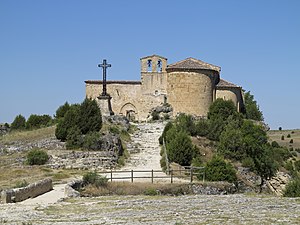Ermita de San Frutos
The so-called Ermita de San Frutos (often also referred to as the priory church ( priorata )) not far from the town of Carrascal del Río in the Castilian province of Segovia impresses both with its location on a ledge above the Río Duratón and with its long history.
history
Some researchers claim to have recognized remains of Roman foundations at the site of today's church. It seems certain that as early as the Visigothic period - that is, towards the end of the 7th century - there was a small church on this site, but no remains of it have survived. The founding of this little church is attributed to the hermit San Frutos, later venerated by the people as saint, and his younger siblings San Valentín and Santa Engracia . Frutos allegedly died here in 715 and was buried in this place by his siblings; afterwards the two moved away and were beheaded a little later by the Saracens . In the 11th century the bones of the venerated popular saints were transferred to the old cathedral of Segovia , where they were forgotten for four centuries. A cemetery with rock graves behind the apse of the church is dated to the 10th to 12th centuries - some of the stone box graves were apparently reused.
The current church was started as a Benedictine priory church in 1093 after the site became the property of Santo Domingo de Silos Abbey in 1076 ; It was completed seven years later and was consecrated by the Archbishop of Toledo . The priory existed until the dissolution of the Spanish monasteries ( desamortización ) from 1835 to 1837.
architecture
Due to its location and its unadorned and windowless walls, the whole complex looks like a small fortress.
Exterior construction
The church is an extremely simple structure with a completely undivided apse into which two (originally three) unframed window slots have been cut. To the south of the apse is a two-arched bell gable . The west facade and portal of the church are made of well-hewn stone material - one has the impression, however, that the portal with its recessed garments and its unadorned archivolts was created a few years later. Above the portal there is a blind arcade - walled up except for a window slot - with columns set to the side and richly profiled archivolts, which can probably be assigned to the second half of the 12th century.
inner space
The single-aisle interior has a width of about 8.20 meters, which is strikingly large for the time; the entire nave is vaulted with a simple half- barrel with belt arch girders , the outward thrust and pressure forces of which are absorbed by iron tie rods that were added later . The entire apse area is completely unstructured and unadorned. The baroque altarpiece with its twisted Solomonic columns in the Churrigueresque style is an ingredient of the 18th century.
Apse , bell gable and necropolis
Legends
According to a legend, San Frutos is said to have carved the small ravine - now spanned by a bridge - into the rock with his staff to protect the place from attacks by the Saracens .
According to an inscription carved in stone, another miracle took place at this point: In 1225 a jealous man plunged his wife, who was suspected of infidelity, into the ravine - but she survived, which proved her innocence. She later donated all of her possessions to the priory and was buried here. (Quote: Aquí yace sepultada una muger de su marido despeñada y no morió i hizo a esta casa lymosna de sus bienes. –– “Here is buried a woman who was thrown down by her husband and did not die; she gave her property to this house as a foundation ( limosna ) "
Web links
- Ermita de San Frutos - Photos + Info (Spanish)
- Ermita de San Frutos - Photos + Info (Spanish)
- Ermita de San Frutos - photos, legends + information (Spanish)
Individual evidence
Coordinates: 41 ° 19 ′ 28.6 " N , 3 ° 52 ′ 50" W.






